24 June 2006
Day 28 - Flying home
The first leg of the trip took us back to Vienna, then came the long haul to Kuala Lumpur. David wasn't doing too well, still suffering from fever and unable to sleep at all. At Kuala Lumpur, we were given the usual 20 minutes to get off the plane and then get back on, so our visit to the duty free shops was brief and purposeful. David, half asleep, decided on an impulse to get a huge 1 kg box of Guylian chocolates, only discovering later what a pain it was to carry around.
We arrived in Sydney early in the morning. When we arrived at the baggage collection area, they started to make announcements listing the names of passengers whose baggage had been left in Vienna. Every few minutes more names would be added and we expected that ours would be among them - not that we would have minded too much: There was nothing in our bags we needed immediately. But no, we got our baggage and made our way through customs - alot more painful than any border control in Europe - to the domestic terminal. After the short hop to Canberra we were met by David's grandma and John, but were too exhausted from the flight to talk a lot about the trip. We were glad to be home, and looking forward to a couple of days' rest to readjust to Australian time.
23 June 2006
Day 27 - Hungarian Parliament Building
After setting David up for the day, Evan headed towards the Parliament Building down by the Danube. On the way there, he discovered a bookshop selling an Hungarian cookbook, in English, that could not be had for love or money in Australia. Our previous attempts to get it had ended up with finding people who were prepared to sell it for about USD 300. It was, however, yet another book to take home in an already heavy suitcase.
Evan arrived at the Parliament about an hour before the next English tour--tours were available in a range of languages including Hebrew. They were free for EU citizens but not for the rest, so Evan bought his ticket and had a look around the surrounding streets. Out the front of the Parliament there was a memorial to those massacred in the 1956 uprising, including a Hungarian flag with a hole in the centre (symbolising liberation from the 'foreign' communist regime by removing its coat of arms). Across the road from the Parliament one of the grand old buildings had smallish iron balls arranged in an interesting pattern all over romanesque architecture. They were clearly former bullet holes from the massacre of those who challenged the regime in 1956.

The Parliament Building itself was very Victorian and was based on the Houses of Parliament in London. It had the standard gaudy grandness--acres of gold leaf, gothic revival vaulted ceilings etc, and some interesting porcelain statues all over the place symbolising an idealised view of the typical Hungarians at the time. There were the standard two chambers. Near the entrance the tour group was shown a model of the Parliament Building made by a family during the communist times out what appeared to be match sticks. It was so big that the to get it out of their apartment, the authorities had to pull a wall down. The family was rewarded for their patriotism with a new apartment.


In the lobby of the Upper House, we were shown the apparently famous numbered brass cigar holders. Members would put their cigars down in a numbered slot to go and hear speeches being made. If the speaker was good, the cigar would burn down and his oratory would be said to be 'worth a Cuban cigar'.
In the central dome, the group was shown St Stephen's crown and other crown jewels in a solid glass case. This is the famous crown with the cross bent at an angle. Why it is bent is a mystery--it may just have been broken at one point but has now become iconic. While we allowed to use flash photography anywhere else in the building, we were asked not to use it on the crown jewels, but of course a handful of people completely ignored this. Tourists!

After the Parliament, even did some shopping at Lush, taking advantage of the exchange rate to get some good deals and bath ballistics to cheer David up. It was then back to the hotel for an early night.

22 June 2006
Day 26 - Gellért Baths

The Gellért Baths.
Taking the tram back into Pest, David wasn't feeling very well and had to get off. We stopped into the nearest store to have a drink to rehydrate and to rest for a moment. We made our way back to the hotel so David could lie down. This was made especially difficult by the traffic chaos that George Bush was still causing.David spent most of the afternoon in bed, doing his best to recover. Evan went out and did a little shopping. Later that evening, feeling a little better, we had dinner at a cheap vegetarian restaurant, Govinda's.
21 June 2006
Day 25 - Buda Hills and Statue Park
Getting off at the highest station, Széchenyi Mountain, we walked over to the nearby Children's Railway. This railway is run by the Young Pioneers, originally a Communist Party affiliated youth organisation. Today the Young Pioneers are apolitical and similar in many ways to the Scouts.
Everyone running the railway (except the train driver) is aged between 10 and 14: The ticket seller, signalman, ticket inspector... It's quite remarkable.

Evan in front of the Children's Railway station at Széchenyi Mountain.

A train on the Children's Railway.
We took the train up to the highest point in the mountains, János-hegy. From this station, we walked up to the lookout and then took the chair-lift back down the mountains, which was relaxing and had a good view of the city. We caught a bus back to Moszkva tér, where we had lunch in Mammut (a large shopping centre).
The lookout at János-hegy.
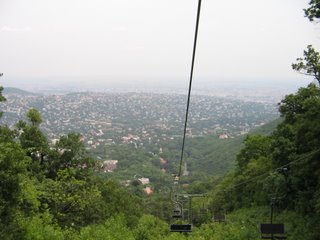
The view from the chair-lift.
Next, we needed to take a tram and then a bus out to Szoborpark, or Statue Park. This park, far out in the suburbs of Budapest is a remarkable place. At the fall of communism in Hungary, communist statues were rounded up and relocated here. The park, situated under tall electricity pylons, is hardly glamourous, and it's a bit neglected. No doubt the exisitance of this park is controversial for many people.The statues and plaques here are interesting. Many are Hungarian-Soviet 'friendship memorials'. Others are statues of figures such as Lenin, and Marx and Engels. A few, perhaps the most controversial, are memorials to those who died fighting against the revoluntionaries in 1956.
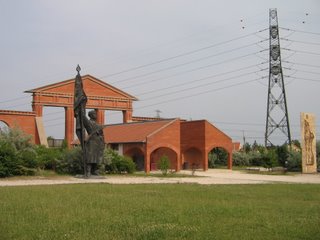
Szorborpark.
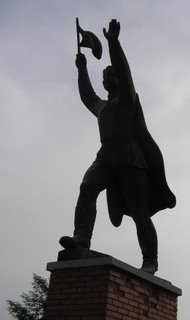
This statue is interesting. It was created in 1951 as a memorial to Ilja Afonoszejevis Ostapenko, a captain in the Soviet Red Army. It was placed on the highway leading out from Budapest to Vienna, and greeted people as they arrived. After the fall of communism, locals didn't want to get rid of their friendly, waving statue!
Back in the city, the tram we caught didn't cross back into Pest as we expected it to (there were lots of announcements, but they were in Hungarian, so we didn't understand). We had to catch a tram at the next bridge. Then, at the main metro station, Deák Ferenc tér, the platforms for the M1 were closed. Leaving the station to walk down to the next station, we noticed that many of the roads in the centre of the city were closed off. The source of all this inconvience, it turned out, was that George Bush was in town. That explained the US flags we'd seem around.Now that our hotel has a kitchen - and after all the expensive restaurants we've been eating at - we went to a supermarket to buy some things to make ourselves dinner. While there we bought ourselves a bottle Tokaji (Tokay) 6 puttonyos (ie. very sweet) wine and a bottle of Unicum.
20 June 2006
Day 24 - National Museum and Hungarian State Opera
The collection in the National Museum is very well presented. It is arranged in roughly chronological order from the stone age through to the 20th Century. Many facinating and varied items are on display. We found the last century particularly interesting, especially the treatment of the two World Wars and the 1956 Revolution. Throughout the communist-era, the propaganda machine denounced the revolution as a counter-revoluntionary revolt, so it is interesting to see it come full circle and be portrayed now as a popular uprising.

The Hungarian National Museum.
We had planned to visit the Electrotechnical Museum (with the world's largest collection of electrical meters) but it was closed. We stopped at at Cafe Károlyi and had a traditional Hungarian lunch.
Fantastic buildings like this are all over Budapest.
We were walking over to the House of Terror museum in the old secret police building when we found ourselves outside the Opera House. We thought we should go in and have a look and we ended up buying tickets to the performance that night. Suddenly, we didn't have much time left, so we rushed back to the hotel to get changed.The opera tonight was Mozart's The Marriage of Figaro. The Opera House is very grand and very ornate and we had great seats. It was a talented performance and very enjoyable, even though the story was silly. It was a fantastic experience.
Getting out fairly late, we had dinner at a restaurant near our hotel, the Premier Étterem. It was very nice in the hot weather to have dinner outside at this Art Nouveau restaurant. The food was very good and the service was very, very polite: Something we noticed as a trend in Budapest, almost everyone is very polite.
19 June 2006
Day 23 - Down the Danube to Budapest

Another hydrofoil in a lock on the Danube.

The Basilica in Esztergom, the largest church in Hungary. Hungary's first king, St Stephen, was born in this town on the Danube bend. It was the capital from the 10th to the 13th Centuries.
Fortunately, we managed to check in ok, and we chatted to a very pleasant American woman also waiting for the hydrofoil - which arrived late. Once onboard the craft the journey was comfortable enough. There were some interesting sights along the way in both Slovakia and Hungary.The hydrofoil dropped us off at the passanger terminal on the Pest side of the river, in the middle of the city. We walked along Váci utca, probably the most touristy street in Budapest, to the metro station at Vörösmarty tér. Unfortunately one of the wheels on David's bag had decided to give up, making it very painful to drag along.
The ticket officer at the metro station didn't understand any English, but with a few Hungarian words and lots of pointing we were able to buy two Budapest cards, which gives discounts to museums and other attractions, and also free travel on public transport.
The M1 line, also known as the Milleniumi Földalatti (Millennium Underground) is interesting. Dating from 1896, it's the second oldest underground train in the world, after the London Underground. Most of the stations have been restored to their appearance at the turn of the century. One of the most remarkable things about it is that it runs just under the surface. We got off at Bajza utca (you can hear the poker-machine-sounding announcement) and our hotel, the Radio Inn, was just around the corner.

A train pulls into a historic station on the metro.
It was a pleasant surprise after all the other European hotels we'd stayed in to have not just a bar fridge but a small kitchen! Finally, we could make our own breakfast and even a cup of tea. In fact the room, really an apartment, was quite spacious. Unfortunately the beds were uncomfortable, but the location was great. Just off leafy Andrássy út and in the diplomatic district.After resting, we went to dinner at the irresistibly named Marquis de Salade. The restaurant specialises in Azerbaijani dishes and the food was delicious, fresh and suited the warm weather perfectly (the cool cellar the restaurant was in also helped). The waiter was exceptionally polite.
Afterwards took the metro back up to Hősök tere (Heroes' Square) and wandered down Andrássy út to the apartment building where David's family once lived.

The Millennium Monument (to mark Hungary's thousandth anniversary in 1896), in Heroes' Square at the end of Andrássy út.
18 June 2006
Day 22 - Bratislava's Old Town Hall and Castle
Undoubtably the eeriest part of the museum was the old jail/dungeons. The pictures and descriptions were too good: We would have been happy not to know what most of the torture instruments were intended for! It was also unpleasantly cold and damp. It was an awful place.
From the town hall's tower there is a good view of the old town.

The tower of the Old Town Hall.
Next we visited Bratislavský hrad (Bratislava Castle) up on the hill. The castle has a long and complicated history, so we were disappointed when we arrived to find that seemingly nothing on the inside had been preserved - it felt like an office space from the 50s. Perhaps we shouldn't have been so surprised.
Bratislava Castle.
The castle also now houses a museum. There was a temporary exhibition about Leonardo da Vinci which seemed to be popular with the locals. Every second display in this exhibition seemed to be advertising for one of the sponsors. Other parts of the museum were quieter, but also less well financed. Again, some interesting pieces including some local Art Nouveau furniture. In the Crown Tower is a replica of St Stephen's Crown of Hungary (Bratislava was at one stage the capital of Hungary) and again good views of the city, especially the river.
A view of the old town from the Castle. On the left is St. Martin's Cathedral, where many Hungarian kings were crowned. At the very top of the spire there is a gilt sculpture of St Stephen's crown.

The Danube and Nový Most from the Crown Tower.
After looking unsucessfully for a laundromat (they seem to be very rare in this part of Europe) we headed back to the hotel to rest.The food at most places looked unappetising; It looks like most places aim to please the British backpackers that are everywhere here. We bit the bullet and had dinner at an interesting, but expensive restaurant, Tempus Fugit. The food was good with an a mix of international flavours.
17 June 2006
Day 21 - Bratislava
Bratislava is only about 50km from Vienna, so while the train wasn't very fast, it was a short ride. Arriving in Slovakia we had our first (quick) passport check since arriving at Vienna airport three weeks ago. The woman at the information desk didn't speak much English (and we couldn't speak any Slovak) but we were able to understand her instructions to get to the bus stop and which bus to catch. A few stops later we were dropped off under Nový Most ('New Bridge' formerly the 'Bridge of the Slovak National Uprising'). It was a short walk to our hotel.

Looking back at Nový Most (with its strange UFO-shaped restaurant and nightclub up top) as we drag our bags over to the hotel.
After checking in we had salad for lunch at Café Mayer in Hlavne Namestie, the main square in the old town. We wandered over to the supermarket to buy some bottled water and also two locally produced soft-drinks: Vinea (a grape-based drink which tasted nice) and Kofola (a cola drink which didn't taste so good).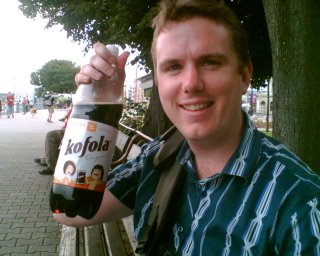
Trying Kofola down by the Danube.
That evening we ventured out of the old town, past the presidential palace to a cheap vegetarian restaurant ('Elixir 14') offering good homestyle Slovakian food.
The main square of the old town, Hlavne Namestie, at night.
16 June 2006
Day 20 - The Esperanto Museum, Hundertwasserhaus, Kunsthaus, Seccesion Building
We wandered down the popular shopping street of Mariahilferstrasse, and stopped into a boardgame store, Spielerei. We bought a small game called Hick Hack in Gackelwack (also known as Pick Picknic).
We caught the U-bahn out to an unusual building. The Hundertwasserhaus is a municipal apartment block in one of the most architectually uninteresting parts of Vienna. The artist Friedensreich Hundertwasser designed this building with several principles in mind: For example, tenants should be able to tell their apartment from the street so all the windows are different, and each apartment is painted a different colour. He also believed that a building shouldn't take land away from nature, hence the plants growing from the roof and out the sides of the building. He also put large golden onion domes on the roof because they are traditionally the perogative of the rich and powerful and he believed the tenants here deserved them, too.
We couldn't get into the building; it is a functional residential building, afterall. We still were able to marvel at surely one of the most unusual blocks of council flats.

One side of the Hundertwasserhaus.
A couple of blocks down the road is another building by the same artist, the Kunsthaus Wien, an art gallery. As it happens it was currently showing an exhibition of Hunderwasser's art, as well as an exhibition of HR Giger. Both exhibitions were very good. The Kunsthaus is obviously a natural and very fitting place to display Hunderwasser's work with its deliberately wonky floors, jarring colours and plants everywhere. Giger's work looked particularly dark in comparison.A particularly suprising display was an Australian flag that Hundertwasser had designed to replace the current one (he had also designed a flag for New Zealand which is quite popular). We bought a small version of this Australian flag in the gift shop as an unusual souvenir.
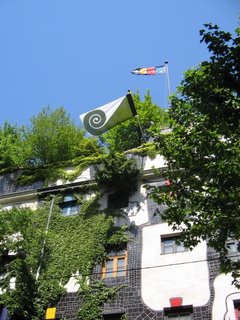
The Kunsthaus, with Hunderwasser's New Zeland flag flying.
Our last stop for the afternoon was another art gallery, the Secession Building. The purpose of the building is to give avant garde artists a space to display their work. The facade of the building, and Gustav Klimt's Beethoven Frieze in the basement are in Secession (Art Nouveau) style, but everything else was contempory art.
The Secession Building. The motto over the door translates as "To every Age its Art, to Art its Freedom."

Part of one of the installation works in the Secession Building, ELEVATOR by artist Dave Hullfish Bailey.
For dinner we headed a bit further out to a vegetarian restaurant called Hollerei which had very nice food outside under the trees. We also got the test the limits of of German-speaking abilities with the waitress.15 June 2006
Day 19 - Schönbrunn Palace

David in front of the Palace.

Evan in the palace grounds, with the Gloriette on the hill behind him.
We went in to pay our admission fee, and chose to get a 'Classic Pass' which gave us access to the 'Grand Tour' of the palace, the Privy Garden, the Maze and an apple-strudel making demonstration.Our ticket gave us a time and a gate to see the palace, presumably to stop everyone going in at once (Versailles certainly wasn't this organised!). We had a quick look around the grounds before heading on in when our time came.
The palace was in a very good state compared to Versailles. Most rooms were in well restored and in good condition, and - shock! horror! - actually had furniture and other pieces. The personal rooms of Franz Joseph, in particular, were well displayed.
An interesting feature of the palace is that there are narrow corridors running between rooms. All the fireplaces faced into these corridors so that the servants did not have to go into the rooms and interrupt the imperial family to check on the fires and add wood. It was also nice to see many of the servants uniforms, and the various places where the imperial family ate meals - the tables were all set and decorated.
One of the many rooms on the tour is a memorial room to the son of Napoleon and Maria Louisa. The product of a political marriage, he became a 'political hot potato' (in the words of our audioguide) when Napoleon's empire collapsed. He spent most of his life (he died at 21) virtually imprisioned in this palace. In this room is an interesting painting of the boy, and a small stuffed crested larch - the boy claimed this bird was his only friend he ever had in the palace.
After our tour of the palace we headed up to the Gloriette. In the heat and burning sun it seemed a long way to walk, and a surprisingly steep hill - but we made it! We used our pass to get on top, which has good views of the gardens and surrounding city. We had lunch in the Gloriette itself, which was ok for a place targetted at tourists.

The Gloriette, built during the reign of Maria Theresa.
Back at the foot of the hill, we wandered through the maze, and eventually got out. We also visited the pretty Privy Garden adjacent to the palace.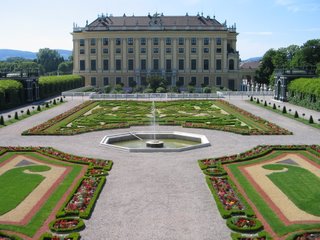
The palace from the Privy Garden.
By this stage we were getting a little tired and were not really in the mood for the apple strudel show, so we gave it a miss.We walked over to the Kaiser Pavilion which is a Secessionist-style (Viennese Art Nouveau) train station that was designed for the imperial family while at Schönbrunn. Unfortunately, it was closed today.
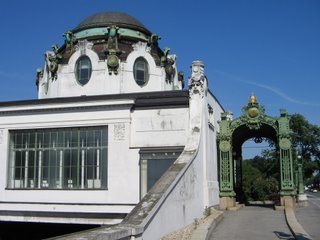
The Kaiser Pavilion.
Later that evening we had Japanese at a place called Yugetsu not far from the Opera. There appears to be many Japanese restaurants in Vienna, and this was recommended as the best. We can't comment on that, but it was a pleasant meal.14 June 2006
Day 18 - Exploring Vienna
The first place we got to use our Vienna Card was at the Clock Museum. This small museum has some interesting pieces. One of the minders spoke very little English, but was very enthusiastic about some of the items and did here best to share that with us.

The clock museum.
After wandering around the Hofburg and the Volksgarten, we visited the Café Central (which our guidebook describes as the "most splendid of coffee houses in Vienna") for lunch. The food was very nice. For dessert David has the hazelnut mousse and Evan tried a Sachertorte.Afterwards we headed back to the famous Neue Burg which houses the Sammlung Alter Musikinstrumente - the musical instruments museum - among other things. The collection of instruments here is huge with many historic or unusual pieces. We also had a quick look at the Hofjagd und Rüstkammer, the weaponry museum, in the same building.

Neue Burg.

A display in the musical instruments museum.

A joustling display in the weaponry museum.
To see a little bit more of the inner city, we hopped on the number two tram and did a few laps of the Ringstraße.For dinner we went to a mostly-vegetarian restaurant called Wrenkh. This restaurant had three menus to choose from ("energy", "balance" and "beauty"). The food here was all very fresh and kept simple - a very nice change. Some interesting combinations of flavours here.
13 June 2006
Day 17 - Travel to Vienna
After doing some errands in the morning, we went to the train station to catch our train. It was lucky we had arrived early, because when we arrived we noticed that the person at the ticket booth had given us a reservation for the wrong day! After typically unhelpful service from the ticket office, we managed to get a new reservation (at extra cost to us).
Deciding to have a drink at the cafe at the train station was a mistake. Receiving rude service from the waiter, we decided to leave without ordering anything. Venice had gotten too much for us.
On the train we had seats in different rows. We're convinced the ticketing staff at Santa Lucia station are hopeless - buy your tickets from another station, or online. The train was half-empty and we had unoccupied seats next to us, so we sat next to each other anyway.
Apart from that less-than-ideal start to the journey, the rest of the trip was pleasant enough. Having dinner in the dining car was a nice way to spend some of the time. Although we wouldn't rave about the food, it was made to order and tasted fresh - and was better than half the stuff we ate in Venice. We weren't sure what to expect from the dining car so it was nice to see tablecloths, full sized plates and real cutlery. The best thing was the stunning scenery.

A castle from the train window.
Arriving in Vienna we easily made our way from the train station to our hotel by catching the S-Bahn (city train syatem) a couple of stops and switching to the U-Bahn (metro). We were at our hotel in minutes.

A station of the very efficient S-Bahn.
For some reason almost every hotel in Vienna (ones that advertise online, anyway) seemed to be booked out for this night, a Tuesday, when we checked a few days ago. What we had to do in the end was stay in a more expensive hotel tonight, and switch to a cheaper one tomorrow. We're not trying to be martyrs, and we're sure you're not feeling sorry for us right now, but that's why we stayed in a more expensive hotel tonight. Our hotel for the night the Radisson SAS Style Hotel which is nice, even though it does have a bit of a generic international hotel feel.
For the first time since we arrived in Europe, our room had a bar fridge (although we didn't have tea and coffee making facilities). I don't think they understand the concept of the mini-bar over here - it was all complimentary. In Australia, at least, the mini-bar is used to squeeze as much money from the guest as possible. Needless to say, we ate and drank everything - we were paying enough for the room.

Our hotel room.
One thing we noticed is how quiet everything is around here, such a nice change from Venice. There's almost no-one about on the streets. Vienna seems to shut down at night.
12 June 2006
Day 16 - Murano and Burano

Murano is alot like Venice, only smaller and a little less crowded.
We started by visiting the glass museum on the island. It was interesting to get an insight into the history of glass making here. We ventured through the rest of the island looking for a couple of stores we had been recommended, and trying to avoid all the stores selling rubbish.
This display was in the glass museum. Apparently these sorts of 'gardens' were once very popular.

Some of the stores allowed you to see glass being blown. Want a glass penguin, for some reason? You've come to the right place.
Some of the stores we visited had some nice things but hefty prices - up to around 30,000€. The shop assistants encouraged us to touch and pick up the pieces. Not at these prices, thankyou!We caught a vaporetto again, out to more distant island of Burano. Burano is famous for its lace, although very little is made here anymore. Disappointingly, we weren't the only people to think of coming out to this little town - the place was packed with tourists. Strangely, though, no-one was in the lace museum, execpt for three old ladies still stiching lace the old-fashioned way. The museum was in the old lace school (apparently quite famous in itself) and had some amazing pieces.

Burano is bright and colourful. It's poor campanile, like many around here, has an unfortunate lean.

Houses in Burano are smaller than in Venice, but packed closer together. There are no courtyards, either, which is why everyone hangs their clothes out in the street.
We had a simple pizza lunch, but got more than we bargained for (we're sure European serving sizes are larger). We decided to walk it off by crossing the bridge to the nearby island of Mazzorbo.Mazzorbo is nothing at like Venice. There's only a couple of shops, a few houses, and lots of open space. It was a refreshing change! I don't think we bumped into another group of tourists while we were wandering.

A green pathway on Mazzorbo.
Back in Venice, we wandered past the Arsenale, the historic sight where the great ships of the Venetian Republic were built. It's still in use by the military, so you can't see that much inside.
David in front of the entrance to the Arsenale.
On the way back to our hotel we stopped into a tiny little electrical store where we saw a chandelier flower for sale in the window. The flower looked exactly like the candelier flowers we had seen in the historic palaces we had visited. We thought this small, inexpensive glass flower is a better souvenir and reminder of Venice than anything we had seen on Murano.That evening we were still too full for dinner, so went out for Ice Cream on the Zattere. Our guidebook recommended three gelaterie (ice cream shops) while we were in Venice: Paolin, Il Doge and Nico. Over the last few days we had tried all three. Our verdict? Definately try the 'Crema del Doge' at Il Doge in Campo Santa Margherita.
11 June 2006
Day 15 - Ca' Pesaro, Ca' Rezzonico, Museo Correr and mask shopping
First stop this morning was Ca' Pesaro. This huge, grand palace has an impressive baroque facade and huge courtyard. Inside however, was yet again another dull, stripped interior. The collection of artwork, however, was a nice change; mostly artwork from the 19th and 20th centuries. One highlight was Gustav Klimt's Salome.
The next palace was Ca' Rezzonico. Unlike Pesaro, there were a few rooms (from a grand ballroom, to a tiny boudoir) here that have been preserved, to varying extents. The top couple of floors, however are plain walls used to display Renaissance painters, which we were experiencing a bit of overload from. An interesting discovery was a preserved Venetian pharmacy from the 18th Century, tucked away in the upper floors.

This style of Murano glass chandelier has been a common feature of all the historic houses we have visted in Venice.

View from the upper floors of the Ca' Rezzonico.
As if we hadn't visted enough museums already, we visited the Museo Correr in San Marco. It has an interesting collection of Venetian items, including an almost complete display of all coins minted for the Republic. Another interesting display showed some of the games and sports played by Venetians.
Attached is the Museo Archeologico, with ancient scuplture. Through these rooms are the grand rooms of the Libreria Sansoviniana. Grand rooms, for sure, it was disappointing the displays were reproductions.
We had intended to buy some masks while we were in Venice, so we'd been keeping an eye out for a good store. While every second store in Venice sells masks, they mostly look the same - probably mass-produced. We spotted one store, Ca' Macana, which had masks that looked a little different. One of their claims to fame, it turns out, are the masks from Eyes Wide Shut. We looked around, and tried a few on, and settled for a couple of nice masks that weren't going to be too difficult to bring home.

Ca' Macana, on the Fondamenta della Toletta.
For dinner, we used the advice of the reception staff to find an Indian restaurant, Gandhi Ji. It was a nice change from the melted-cheese brigade. Food was good, staff were friendly and the prices were ok.